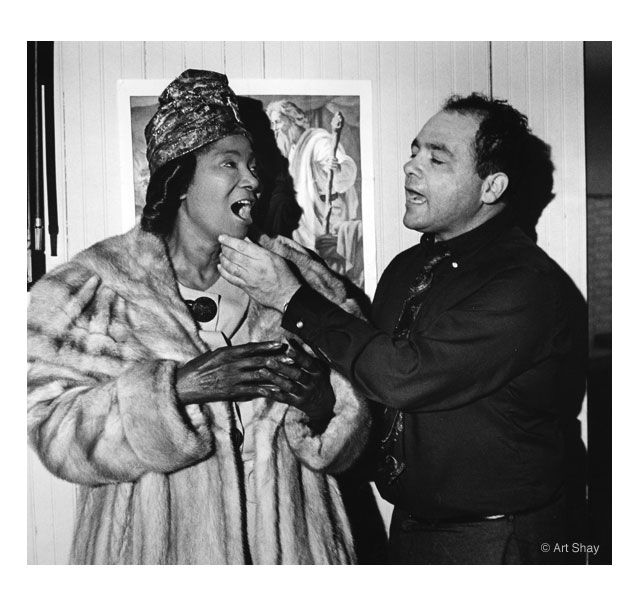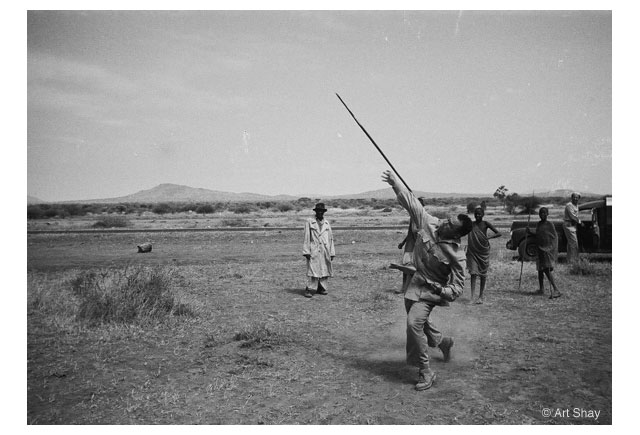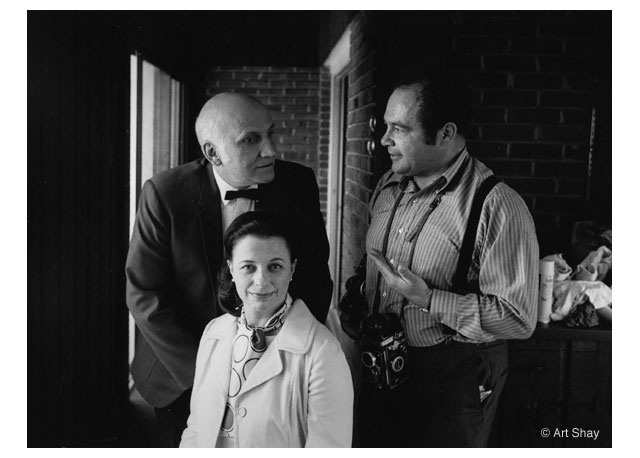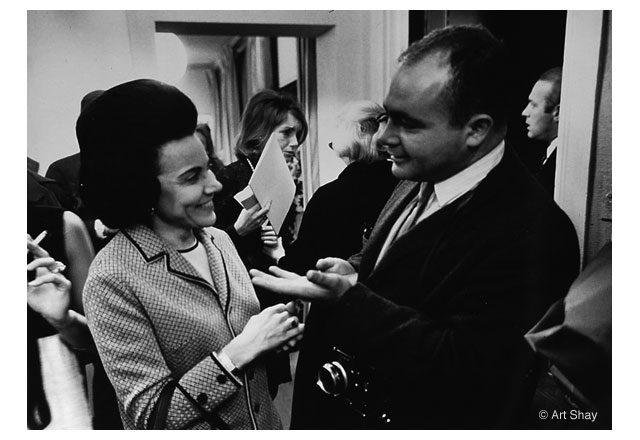From The Vault Of Art Shay: The Gifted Amateurs
By Art Shay in News on Feb 27, 2013 8:00PM
(Legendary Chicago-based photographer Art Shay has taken photos of kings, queens, celebrities and the common man in a 60-year career. This week, Art looks at people gifted at something besides their professions)
"God protect me from the gifted amateur." —George Bernard Shaw (1856-1950)
"George Bernard Shaw, after lunch at Ayot St. Lawrence, was marveling at my Leica," said my friend David, "and equating shooting a Leica with 35-mm film to the thousands of roe it took to create one fish," when the subject of amateur snapshooting came up. It was in reference to a famous, dramatically tilted picture made on the deck of the sinking liner Vestris. The gifted amateur who made the classic shot was crew member Fred Hansen, who had bought the Eastman Kodak folding camera (the kind my father lent me to start my career!) the night before sailing. The $8.50 Fred paid apparently included six rolls of film! The picture became iconic because it not only depicted the penultimate tilt of the deck before deep-sixing, but Fred also captured the panic on the face of a frightened, unbalanced passenger as well. I suppose this masterful shot is the exception that proves the rule.
My old friend, the late intellectual Life Magazine photographer and writer David Scherman, the scion of the family that founded the Book of the Month Club, was ruminating for several of us literary junkies who found ourselves doing Ford's now classic fiftieth anniversary book in 1953. Through the years, David was one of the three photographers Life allowed near a typewriter. David Douglas Duncan was the second. Grudgingly, Life allowed John Bryson (who did the great Katharine Hepburn book) and me, the same privilege. Most of Bryson's and all of my writing were printed anonymously. Life was a picture magazine, and the great editors kept the world of photo-journalism on constant notice that this was so. It worked both ways.
When I worked as a staff reporter in NYC, Washington, San Francisco, or finally, in Chicago, the only time I could legally handle the camera without losing my job was to load it with film for a bona fide Life photographer. Thus, some twenty of my best "amateur" pictures, made slyly with a camera I was loading, splashed big -- but under different names than mine. Three I remember shooting as an amateur: Two pagers of Henry Wallace campaigning for ultimate re-election in San Francisco in 1952 by holding up a giant squash with his name hacked into it, stripper Gypsy Rose Lee strutting on the bally stand outside the show tent at the Royal American Show playing the Cotton Carnival in Memphis c 1948 (we stayed at the Maxwell House!), and a picture of a San Francisco flagpole sitter that ran with an anonymous Life Report I wrote on a flagpole-sitter in his third week aloft.
I well remember the 1948 story, but better remember my story being on the Life story list for a month, atop one by the great American novelist, John Dos Passos. My literature-loving father was impressed with the concatenation. His son the amateur writer linked with Dos Passos. My father, who had revolted in the same St. Petersburg cell as his writer friend Leon Trotsky, never imagining Leon would ultimately have an affair with Frieda Kahlo before being killed by a Stalin claw-hammer murderer sent to Mexico by Stalin. My father, who was a fine self-taught writer of letters to all four of us sons in his second language, learned from reading the New York World and Daily Worker newspapers during and before Depression I. "Roosevelt is pulling us out of the Depression but the Republicans are still in love with Herbert Hoover who got us into this mess. They are so selfish and small-minded. So stupid! So -- un-American. And they call us workers un-American because we talk with an accent. We love America better than they do."
Of all the literary lights that had glowed for my friend David, he best remembered basking in the glow cast by George Bernard Shaw one golden forties morning at Ayot.
"Shaw held forth on how, when his interest on photography was made public, dozens of people began thrusting their albums on him. 'Your dogs sir, and your wives, and your offspring,' he'd mutter, 'you should keep as personal secrets -- not wholesale them to the world.'"
"He was especially pissed off at amateur writers, or rather their relatives who carried pages of 'argerol-stained' manuscripts to me, over which I was supposed to imprecate over or otherwise get published." Pause. Then he aphorized: "God protect me from the gifted amateur." Of course he believed less in God than he did in amateur scrivening. "He told us, 'Hell is full of musical and literary amateurs -- and I intend to avoid them when I arrive.'"
He also told Dave that a lady came up to him at a book signing bearing a manuscript written by her nephew. She handed it to an unaccepting Shaw. "It's very good," she assured him, "but I wondered if you could help him choose a title?"
"Does it have drums in it?" asked GBS.
"Why no --"
"Then have him entitle it 'Without Drums.'"
Not an hour's journey through Hertfordshire to London, Sir Thomas Beecham not only conducted the London Symphony Orchestra, but after rehearsals patiently listened to the sub-melodious instrument and vocal sounds made by aspiring musician sons, daughters, nieces, and nephews of members of Parliament. One day, 12 feet in front of him, sat a young woman playing her cello for Sir Thomas.
He stopped her after two bars. "My dear miss," he purred, "you have between your legs an instrument capable of bringing pleasure to thousands -- and all you are doing is scratching it."
Once a month it is my fate to receive in the mail at least one 11x14-inch envelope crammed full of some amateur photographer's black and white prints. Now that digital is here, color has been added. Typical letter: "I don't know if you remember me. I was at your recent gallery opening -- you posed for my Leica and the print is enclosed -- I can Photoshop your chin if you want me to...I recently have returned from a trip to my mother-in-law, who lives in Washington, DC. As you can see from my pictures, I spent a lot of time trying to get the Washington Monument into the same picture as the Lincoln statue. Do you think I have what it takes to go on and become a photographer for National Geographic, where I could combine my love for traveling with my newly discovered interest in photography? If you tell the Geographic you're going somewhere do they ask you to keep your eyes open for something exotic? Do I need releases from dancing girls in Thailand, where we expect to go next vacation if I don't lose my job? That's my wife's mother saluting President Lincoln, who was one of our best, she feels... She used to be a WAAF and quite possibly could have ferried the B-24 you mention in your book that you signed to me that I already treasure and I've shown to our local camera club who don't believe I know you and are looking at my pictures. God, you guys really were the Greatest Generation..." The main trouble with his pictures was that Martin Luther King and 200,000 others were absent from the frames. Also, for a buck you could have bought better postcards.
A UPS man, years ago, kept after me to look at his work. I advised him to find a subject, a theme, a situation...He did. He photographed Chinatown and in 200 frames failed to show one Chinese person. He had window displays, close-ups of fortune cookie aphorisms, close-ups of Chinese scrolls, a hand marking down the price of day-old beef almandine.
Then, at the very bottom of his pile there was a real picture -- a non-Chinese man on the train at the peak of a monumental yawn. "That's great!" I enthused.
"Can you get Life to buy it?"
"Yes," I said, if you get eight more shots of that peak moment of a yawn. Especially on the subway."
He looked at me as if I were nuts. "You know how many hours I'd have to ride the train to get even one more shot like that one? I mean I was just pointing the camera when he yawned."
"Yes," I said. "Maybe ten hours. Maybe over five days..."
"And what about my job?" he asked.
This guy was about 6-foot 6. So I hired him for a hundred-dollar-day's work schlepping my camera and light cases on a job for Fortune. The Underwriter's Lab had agreed to let me photograph a new roofing material as they set it on fire in their new super-heated burn room. The insulated room was 10x10. The only place to shoot was from a 4-inch asbestos peep window. Fortune was going through an anti-35 mm stage, so I sat my big 4x5 inch Linhoff view camera right at that peephole and had my new assistant hand me fresh holders of film as the burn progressed. When it was all over and we were trudging back to my car he said, "I was thinking how I'd do it."
"Good," I replied. "How?"
I would have left the camera inside," he said, and covered it with a sheet of asbestos. Then run a cable release to the outside."
"You mean have them drill a small hole through the 9-inch wall for it?"
"You got it," he said.
"And what about the lens?" I asked. "That's a $560 Zeiss Angulon wide angle. That's a 5,000 degree fire in there."
"Doesn't anyone make a heat-proof lens?" he asked.
"I'll call the space program," I promised.
An earnest patcher of our town's potholes nailed me in the driveway with his envelope of pictures. They showed four guys getting haircuts in a local barbershop.
"Where can I sell these?" he asked. "It's the best thing I've done."
"Maybe the barber would give you a free haircut for them?"
Not what he meant.
I alienated one of my distinguished photo-collectors who wrote forewords for my last two books, amateur fotog David Mamet. I helped David find a WWII Kodak Retina he'd wanted for years. He sent me a print from his first roll -- Mamet shooting himself in a motel mirror, probably on some movie location.
I told him it was a good snap but not to give up his day job. I think I pissed him off.
So who's going to write my next two forewords?
As you can see, I really understand the ambitions of the professional amateur...
If you can't wait until this time every Wednesday to get your Art Shay fix, please check out the photographer's blog, which is updated regularly. Art Shay's book, Chicago's Nelson Algren, is also available at Amazon.





